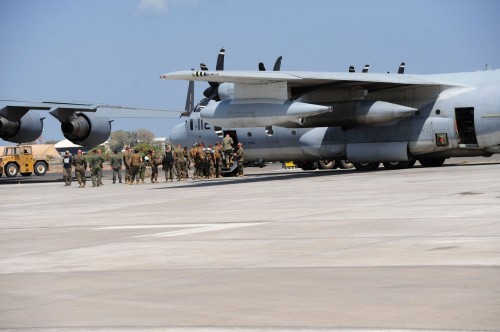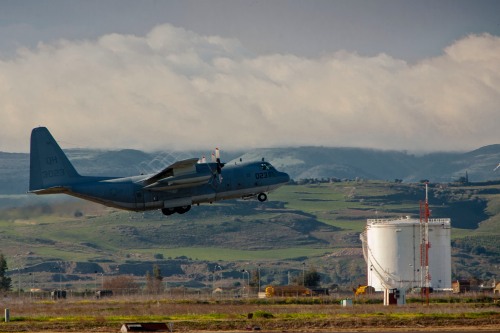Last week, a CASA 212 light transport reportedly full of United States special operations forces was forced to land on a strip of road in Uganda, less than 100 miles from the capital Kampala. The plane had reportedly developed a undefined technical fault on its way to Juba, South Sudan and had to turn back. Unfortunately, the crew had to set the aircraft down outside of Kiwawu after running out of fuel. Thankfully, no one was hurt, though a local NTV Uganda television spot showed how the Americans held up traffic until their transport could be moved.

Soldiers from the East Africa Response Force load on a C-130H from the 52nd Expeditionary Airlift Squadron at Camp Lemonnier, Djibouti en route to Juba, South Sudan in December 2013.
The incident offered an opportunity to highlight the role of private contractors providing airlift services in Africa to the US military. The CASA 212 in question was identified by its civilian registration code N604AR. The owner is EP Aviation, LLC, which acts as a subsidiary for the AAR Airlift Corporation. EP Aviation is fulfilling a contract to fly members of Special Operations Command, Africa (SOCAFRICA) around central Africa, generally defined by the US military to include Uganda, as well as Central African Republic, the Democratic Republic of Congo, and South Sudan.
After doing a little digging, I found that there was a dispute between AAR and Evergreen Helicopters, which had previously held this contract. Evergreen has since started doing business with the US government as Erickson Transport, Inc, after having been bought by Erickson Aviation. Erickson’s website shows portions of the fleet of fixed wing aircraft and helicopters still bearing Evergreen’s logos. Erickson has now also disputed the award of a contract to provide rotary wing support to SOCAFRICA to AAR. You can find more of the details on in my recent piece on War is Boring.
In addition, I recently contacted Combined Joint Task Force – Horn of Africa over the recent announcement that the 75th Expeditionary Airlift Squadron had been activated at Camp Lemonnier, Djibouti back in May. The 75th EAS joins the 81st and 82nd Expeditionary Rescue Squadrons assigned to the 449th Air Expeditionary Group at America’s east African hub. The 449th AEG is one of three AEGs assigned to US Air Forces Africa (AFAFRICA).
C-130 airlifters and crews will rotate through deployments to the 75th EAS. The planes are responsible for a variety of logistics missions in east and central Africa. The 75th EAS also completely replaced the previous 52nd EAS, which had been activated in October 2013. The 52nd EAS was the first ever expeditionary airlift squadron to be assigned directly to AFAFRICA. This creation of a formal military airlift presence on the continent is significant in the context of the reliance on contractor-flown airlift already mentioned here. I provided some additional details on the 75th EAS and its mission in another piece on War is Boring today.

Members of Special Purpose Marine Air Ground Task Force – Crisis Response board a KC-130J at Camp Lemonnier, Djibouti, as they prepare to return to their base in Spain on 1 March 2014.
Its also worth noting that the US Marine Corps has identified similar airlift requirements for its missions on the continent. This aircraft needs are clearly part of the reason why both the security assistance-focused Special Purpose Marine Air Ground Task Force – Africa (SPMAGTF-Africa) and the contingency Special Purpose Marine Air Ground Task Force – Crisis Response (SPMAGTF-CR) both have organic KC-130 aircraft. There was also a report earlier in the year that Marine Transport Squadron One (VMR-1) was supporting the movement of SPMAGTF-CR elements with their C-9B Skytrain and UC-35D Citation aircraft. It was unclear, however, whether this involved movement to and from countries in Africa. SPMAGTF-CR, while Africa focused, is based in Europe and has forward deployed contingents to countries like Italy and Romania this year.

